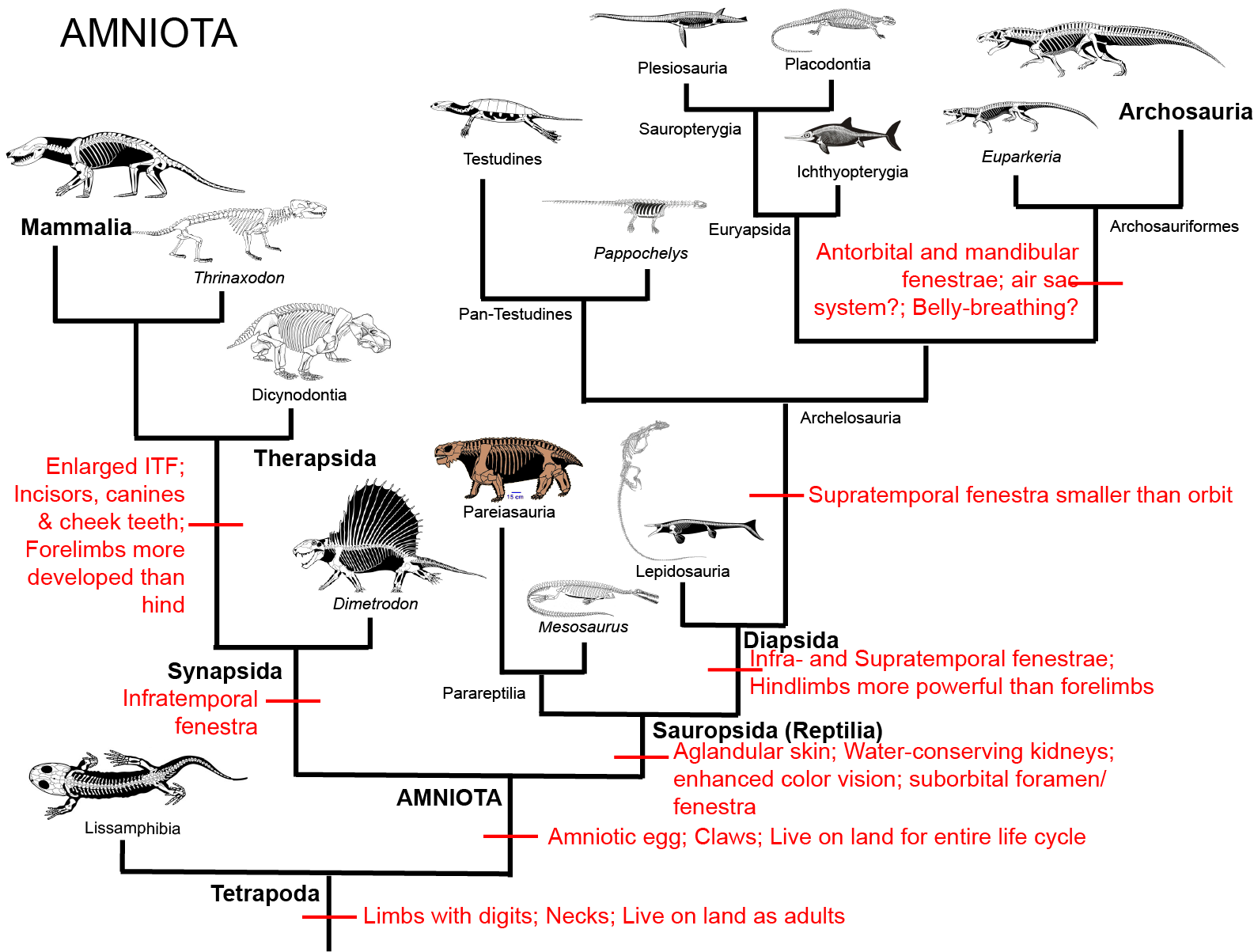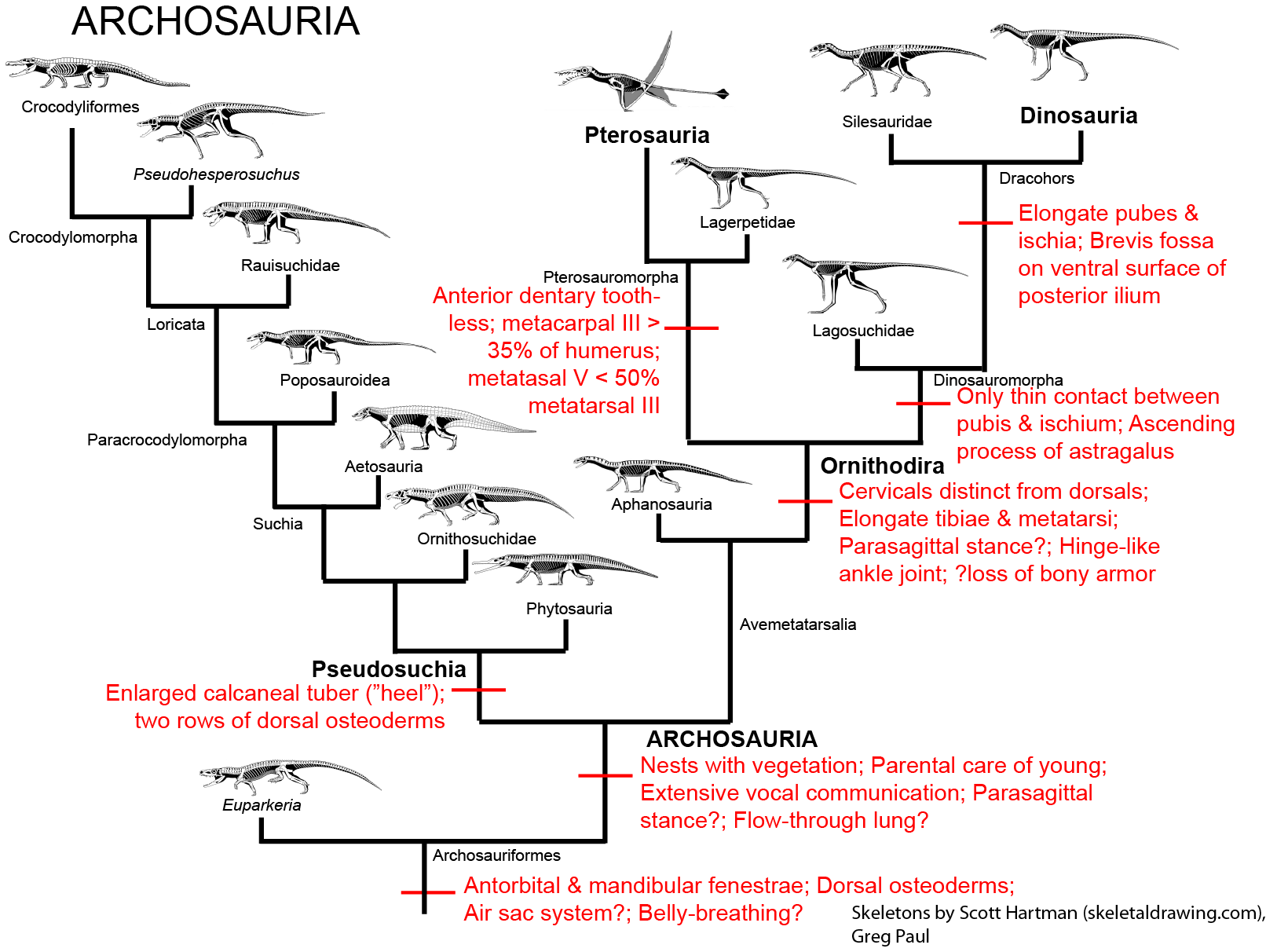

I. The Colonization of Land
Life on Earth first evolved in the seas over 3.5 billion years ago, and even today the majority of
living things are aquatic. The terrestrial realm of land and air offers many challenges to organisms
adapted to aquatic life:
The first organisms that spent at least sometime out of water were algae mats along the edges of seas and lakes (which are among the oldest fossils known!) But for over 3 billion years life was essentially limited to the water. By the early Paleozoic Era, the marine realm was as crowded with living things as the modern oceans, but the land was still mostly barren: perhaps some lichens and bacteria, but not much more.
Among the first fully terrestrial organisms were true primitive plants that had colonized land by the Silurian Period (443.4-419.2 Ma). (Some fossils show that they actually had colonized at least by the earlier Ordovician Period, but were apparently not widespread.) The terrestrial world offered the primitive plants mineral resources and plenty of more space (to collect sunlight!) than could be found in the crowded seas.
The first terrestrial animals were various types of arthropods (bugs, broadly defined): the ancestors of millipedes and centipedes, the earliest arachnids, and the ancestors of insects were established on land in the Silurian Period. These ate the early plants, and each other.
(Other groups, such as earthworms, other worms, snails, and so on colonized during this time.)
The ancestors of the dinosaurs (and us!) during this time were still entirely aquatic. Primitive vertebrates were all aquatic: in other words, they were fish. ("Fish" is simply the name for all vertebrates that aren't tetrapods; there are many diverse lineages of vertebrates other than the land ones!).
In the early part of the Devonian Period (419.2-358.9 Ma), the fish continued to diversify. This diversity included many sorts that lived in freshwater.
Freshwater has its own problems compared to sea water, but various types of fish evolved traits to deal with them:
So by the later part of the Devonian Period there were vertebrates which had a bony skeleton to support their bodies; bony limbs with wrists, ankles, and digits to push along on land or on the lakebed; lungs to breath air (but still had gills to breath in the water).
Many of these Late Devonian stegocephalians still lived their lives essentially only in the water (such as Acanthostega), and thus were essentially fish-with-fingers. Others (such as Ichthyostega) may have gotten most of their food from land. It was from these latter sort that the more fully terrestrial vertebrates--the Tetrapoda ("four footed ones"), would evolve.
During the early part of the Carboniferous Period (358.9-298.9 Ma) the early tetrapods became established. Unlike earlier stegocephalians, these had necks (that is, the skull was not attached to the scapula), which allowed them to bend their heads down to capture food on land. Like fish, these early tetrapods still laid their eggs in the water and their young (tadpoles) often had gills. As adults, though, many were more terrestrial.
In that way, the early tetrapods were "amphibians" in the broad sense of the term. However, these were often scaly-skinned (like fish), unlike the naked-skinned Lissamphibia (frogs, toads, salamanders, etc.: the modern clade of amphibians). Carboniferous and Permian (299-251 Ma) Period primitive tetrapods included a great diversity: snake-like forms; primarily aquatic boomerang heads; alligator-like forms; and many others. But even for those forms which spent most of their adult lives on land had to come back to the freshwater to reproduce.
During the Carboniferous, however, one group of tetrapods evolved an adaptation that allowed them to break free of the pond: the amniotic egg. Instead of being a "naked" egg laid in a pond or stream, the amniotic egg had:
In other words, tetrapods were now freed from the water. As such, the tetrapods with an amniotic egg did not have a
larval ("tadpole") stage, and so they were terrestiral for their entire life cycle.
This adaptation marks the evolution of the most successful clade of tetrapod, the Amniota:

Other than the amniotic egg, amniotes are also characterized by claws. Also, the basal members of most amniote groups have an opened region behind the eye, representing the infratemporal fenestra. (Temporal fenestrae allow more powerful and quicker bites. Non-amniote tetrapods and and some primitive reptiles have/had no temporal fenestrae, and so had weaker and/or slower bites than synapsids and diapsids [more about them later...]). Traditionally it was thought that the common ancestor of all amniotes lacked any temporal fenestrae (i.e., had an anapsid skull condition, like amphibian-grade amniotes). However, recent evidence shows that basal reptiles have either a complete infratemporal fenestra (that is, a hole surrounded by a ring of bone) or an opening for the same muscles, but having no lower bony bar.
II. Life on Land Before the Dinosaurs
Amniotes first appear in the later Carboniferous Period.
At this time, many low-lying parts of the land were covered in
vast coal swamps (so called because the buried remains of these swamps make up the majority
of the coal deposits of the Northern Hemisphere). While the fish-eating tetrapods stayed near the ponds,
the amniotes were free to pursue other prey
further onto land. With access to this new environment, the amniotes underwent a series of
adaptive radiations.
Amniotes divide into two major divisions:
The synapsids were the first group to radiate. Synapsids are characterized by a skull with a complete infratemporal fenestra with a lower bar but no supratemporal fenestra.
During the Early Permian Epoch primitive synapsids radiated into many different forms:
These early synapsids would have had the sprawling stance found in primitive tetrapods in general. They almost certainly would have been "cold-blooded" (the ancestral state for vertebrates). So traditionally these animals have been considered "reptiles". However, they lack the shared derived features of reptiles (see below), and are instead simply primitive synapsids. (In traditional taxonomy, these were put in the group "Pelycosauria", but this is a paraphyletic group: all synapsids except for therapsids). New discoveries show that even early synapsids had some parental care.
The early synapsids evolved themselves into extinction: that is, they were replaced in the Middle and Late Permian Epoch by the Therapsida: the advanced synapsids. Once called the "mammal-like reptiles", they are not true reptiles. Instead, they are the advanced branch of the synapsid phylogeny. They differed from earlier synapsids by:
The Middle and Late Permian therapsids included:
Ancestrally, all vertebrates are cold-blooded (warm their bodies primarily using sunlight). However, some evidence suggests that the advanced therapsids of the Late Permian may have had elevated metabolisms (that is, were at least partially warm-blooded):
Additionally, some therapsids seem to have had parental care of the young, keeping them in burrows.
Reptiles tended to be relatively rare in the Carboniferous and Permian Periods. Reptilia is characterized by a number of particular skeletal features (which we aren't going to deal with here, as they are fairly technical). Modern reptiles (and by inference, their concestor and all of its descendants) share a number of soft-tissue features:
There is a major clade of basal reptiles which flourished alongside the synapsids during the Permian, but became rarer in the Triassic. The most primitive of these groups (the aquatic Mesosauridae) is known (since 2012!) to have an infratemporal fesestra, but most others have the no-fenestra (anapsid) condition. Because of this, they are traditionally called "Anapsida", but now called "Parareptilia" (or sometimes "Proganosauria"). Parareptiles underwent a radiation in the Permian, producing:
Other primitive Carboniferous and Permian reptiles show the anapsid condition, but were eureptiles (the clade containing diapsids [see below] and their closest relatives).
Relatively rare during this time are the oldest known members of Diapsida. This would eventually evolve into the major clade of eureptiles, and the dominant clade of amniotes during the Mesozoic. Changes from the ancestral reptile condition to Diapsida include:
During the late Paleozoic diapsids were only a very minor part of the ecosystem.
In general, compared to typical Mesozoic and Cenozoic ecosystems, the late Paleozoic land vertebrates were smaller (few ox- or hippo-sized, none larger), slower (no real speed specialists), and close to the ground (only a few gliders and no powered fliers; few tree-climbing specialists).
At the end of the Late Permian, the greatest extinction in the history of life clobbered ecosystems on land and sea. This event totally changed the make-up of the diversity of life, and forms the boundary between the Permian Period of the Paleozoic Era and the Triassic Period of the Mesozoic Era. Consequently, it is called the Permo-Triassic Extinction. Perhaps 95% of all species died out.
The cause seems to ultimately have been the Siberian Traps, a monumentally huge series of volcanic eruptions. These raised global temperatures through extremes of greenhouse gasses; this further triggered additional greenhouse gasses being released from the sea floor. Together, extremes of heat and of carbon dioxide and very low levels of oxygen caused mass deaths.
Regardless of precise scenario, extinction reorganizes the world. In the immediate aftermath, there was a great reduction in size and diversity of the animals present.
Lost were many of the primitive therapsids and many of the primitive reptiles.
During the Early Triassic diversity started off very low in land and sea, and recovered over the next ten million years or so. On land, more advanced carnivorous therapsids were the dominant predators, and piglet to ox-sized herbivorous therapsids were common. But the reptiles (and especially diapsids) began to radiate into the number of different forms:
These new predators were the precursors of Archosauria ("ruling reptiles"), the dominant group of
Mesozoic reptiles.

Archosaurs and their closest relatives are distinguished from other diapsids by:
It is not certain if these early archosauriforms had the behavioral traits found in both the living groups of Archosauria (that is, crocodylians and birds). Because both crocodylians and birds share the following derived traits, however, it is fairly certain that at least the concestor of all Archosauria had them, and passed them on to its descendants:
Middle and Late Triassic reptiles, and diapsids in particular, radiate into many different forms:
A great diversity among the Middle and Late Triassic reptiles, though, were archosaurs. During the Middle and Late Triassic, the archosaurs displaced the therapsids as the dominant group of large terrestrial amniotes.
Archosaurs are divided into two main branches:
It is the crurotarsan which dominated the Middle and Late Triassic. This group radiated into a number of forms:
The crurotarsans include some of the first terrestrial animals to exceed the size of oxen and hippos. Most of them could stand with a semi-erect posture of the limbs, and a few had the fully-erect (that is, parasagittal gait).
Although crurotarsans may have been the dominant group, plenty of other forms abounded in the Middle and Late Triassic. These included the last of the big beaked therapsid herbivores; more advanced, but generally small therapsids (including the oldest mammals: more about them later); many non-archosaurian diapsids (see above); and...
The First DINOSAURS!
(As we will see next...)
To Next Lecture.
To Previous Lecture.
To Syllabus.